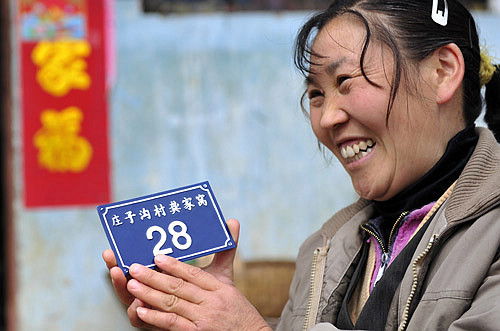|
 |
|
FOND MEMORIES: Hu Fengying, who will soon move to a new home, keeps the number plate of her old house as a memento (HAO TONGQIAN) |
Since 2005, the government has increased the height of the reservoir's dam from 162 meters to 176.6 meters in order to store more water for diversion to the north. The water level has since risen from 157 meters to 170 meters, and the acreage of water surface has increased from 800 square km to 1,050 square km, so that many villages around the reservoir, including Miaowan, will be submerged.
Figures from the South-to-North Water Diversion Office of the State Council show that after the Danjiangkou Reservoir dam is heightened, 330,000 people—180,000 from Hubei Province and 150,000 from Henan Province—living around the reservoir will need to be relocated.
Since 2008, a trial relocation program involving 23,000 people has already been carried out in the two provinces to prepare for the much larger migration. Miaowan was one of the villages selected for the trial program.
Du Bingzhao, a division chief of the South-to-North Water Diversion Office of the State Council, said the trial program has mostly finished, and after analyzing the results and fixing any flaws, mass relocations around Danjiangkou Reservoir will begin next year. Relocation programs in the two provinces are slated to wrap up in 2012.
Assisting
Mass relocation programs are nothing new to China, especially in relation to large-scale hydropower projects. Construction of the Three Gorges dam, which began in the mid-1990s, required the relocation of over 1 million people, the largest relocation in modern Chinese history.
Tian Chengzhong, Vice Governor of Hubei Province and also the official in charge of the province's relocation project, said the personal and emotional costs for some migrants will outweigh the benefits of moving.
Tian said at a group interview in late May that among the 180,000 people from Hubei to be relocated, 100,000 would be moved to places within a reasonable distance from their former villages. The most affected are the other 80,000 who have to move far from their old homes. They will be relocated in 194 resettlement places in 18 counties in the province.
To help migrants settle into their new environments, Hubei Province stipulated that each migrant be given a piece of high- and stable-yield land. Each family should also be provided with a good living environment. Besides additional compensations, every migrant will receive further support from the government, and every qualified migrant can get rural endowment insurance while families are eligible to have one member trained for other skilled labor jobs.
"We're open to hearing suggestions from the migrants and will try to satisfy their needs," Tian said.
Most of the migrants are choosing to settle near highways and the suburbs, Tian said. In the resettlement places, public utilities, including water, electricity, telecommunications, postal services, broadcasting and television, hospitals, schools, employment and social security services will be ready soon.
Xiangfan has received the most migrants. Li Yaohua, Vice Mayor of Xiangfan, said the governments of resettlement locations must care for their new residents and help them adapt to local societies as soon as possible.
Xiangfan has formulated many measures and set up a working team to help with the adjustment. All team members are township or village cadres and each is assigned a family to assist after relocation. In Laolijia Village, the name and telephone number of the designated supporting team member are posted on the gate of each family's new home, and migrants can ask the supporting team member for help at any time.
Welcoming
Tang Huijun, a native of Laolijia, has lived here for more than 40 years. Tang has welcomed the migrants with open arms, since, she believes, it's not easy leaving one's native place, even for the sake of national construction. When migrants moved here in March, she helped them carry their belongings and made small talk to ease the stress of moving into a new house.
"We are neighbors now," Tang said, "and we need to be able to get along with each other."
Tang's family used to own a hectare of cultivated land. In order to resettle the migrants, the government recalled 0.6 hectares and compensated Tang for the recall.
"We don't depend on farming for living now, so it wasn't a big deal when the government took over the land," Tang said.
In Liangshuijing Village of Xiangfan, two rows of two-story houses are nearly finished, and there is a nice green lawn in front of each house. The village will receive 21 families from Jiangkou Village near Danjiangkou.
Native and newly built migrant houses, all two-story structures, have their distinct features. The new houses are built in the style of their owners' old homes in the Danjiangkou area, causing them to stand out a bit.
Fu Bingping, a representative of the villagers from Jiangkou Village who supervises the construction of the new houses, said he once feared that the locals would discriminate against the migrants. But after visiting the area several times, Fu changed his attitude, especially after he was invited over for dinner by local families.
Fu also said the local people have promised to show them how to grow grain crops after they settle into their new homes—a warm welcoming gift since many from the Danjiangkou area used to grow citrus products only. | 